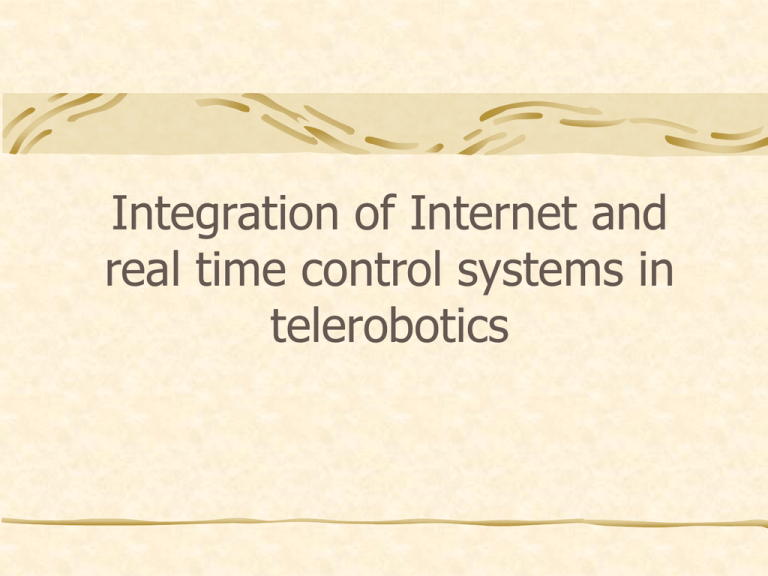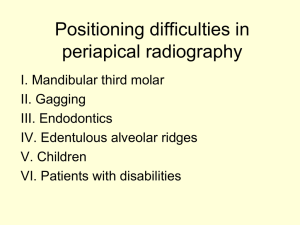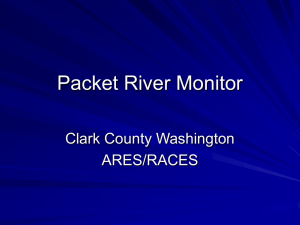Document
advertisement

Integration of Internet and real time control systems in telerobotics Introduction Many devices are today accessible through Internet: Web cams Washing machines, coffee pots and other appliances Robots The term “control” is referred to the possibility of sending a list of commands to the remote device Introduction Note: The control loop is not closed across the network The remote equipment executes the commands under the supervision of its own local controller Why? The unpredictable performance does not allow the realization of an Internet-based, real-time control system, in which the control loop is closed across the network Introduction Question: If the characteristics of the Internet connection in use are known, is it possible to implement a real-time, closed-loop control system, integrating that connection? Answer: JBIT – Java Based Interface for Telerobotics: a telerobotics equipment for real-time teleoperation over Internet, with visual and force feedback Introduction Closing the loop across Internet… Internet Local system Internet Internet Remote system Summary Internet modeling Delays, losses and bandwidth Control of dynamic systems with variable time-delay Solutions available in literature Packet loss handling The JBIT project Internet modeling Internet can be considered as a strongly connected network of computers, communicating with each other using packetswitched protocols To B To B B To B To B To D A C D Internet modeling From source to destination, each packet traverses several nodes Each node has different throughput, routing policy, and buffering and queues management Each node handles many other data flows, this resulting in random service time Internet modeling When the data flow between end users exceeds the available bandwidth, congestion occurs The available (or marginal) bandwidth for a single user depends on the data flow generated by other users, sharing the same physical connection Internet modeling End-to-end connection modeled by: Average delay Available throughput Delay statistics/variations Packet loss statistics Simple experiments to get the model ICMP packet injection and Round Trip Time (RTT) measurement Internet modeling RTT vs. Time: Short term Long Term (1 week) Internet modeling RTT distribution: Depends on the number of nodes traversed: 10000 km connection 30 km connection 5 hops 1 2 3 4 5 6 arianna.dei.unipd.it dei-cisc.dei.unipd.it 147.162.6.254 pd4000.unipd.it 147.162.5.254 berica2.gest.unipd.it 1 2 3 4 5 6 7 8 9 10 11 12 13 14 15 16 17 18 arianna.dei.unipd.it dei-cisc.dei.unipd.it 147.162.6.254 pd4000.unipd.it cnaf-gw-2.infn.it cnaf-gw1.infn.it 131.154.8.1 mix-serial3-4.Washington.mci.net core1-fddi-0.Washington.mci.net border1-fddi-0.Bloomington.mci.net border1-fddi-0.Bloomington.mci.net csunet-losnettos.Bloomington.mci.net ISI-SWRL-GW.LN.NET acg-isi.ln.net jpl-acg.ln.net 192.138.85.65 b198-fddi.jpl.nasa.gov helios.jpl.nasa.gov 17 hops Internet modeling RTT distribution: 30 km Exponential-like 10000 km Gaussian-like Internet modeling RTT phase plots (RTTn+1 vs. RTTn) rttn+k+1 = rttn+k + P/ - Non-congested Congested Note: P is the packet length, is the channel throughput, is the period of the probing packet Internet modeling Available bandwidth can be obtained by injecting a data flow that brings the connection close to saturation. The closer to saturation, the higher the packet loss rate Host name Average RTT [msec] Berica 10 8.44 Helios 10 319.0 Berica 100 8.10 Helios 100 326.3 Std. Dev. [msec] 6.25 16.70 5.35 27.20 Packet Loss rate 5.97 51.13 0.08 41.36 Internet modeling - Summary Available bandwidth, average delay, delay deviation and loss rate can be easily obtained with simple injection of probing packets Saturation can be avoided by setting the upper limit of the application throughput below the available BW Control over Internet Closing the loop across Internet Internet Local system Variable delay 1 Variable delay 2 Remote system Control over Internet Few solutions available in literature for timevarying delay All algorithms are designed on the basis of maximum delay and its max. derivative Structural constraints: With Internet, short interruptions may occur Decentralized control is preferred In case of interruptions, it must be allowed to have reduced perfomance Control over Internet Other solution: provide a pair of queues to even out the delay jitter In this case, all constant-delay techniques can be applied (e.g. Smith predictor) Control over Internet Which protocol is best suited for Internetbased control? TCP: Acknowledge mechanism interrupts control loop RTP: Oriented to audio-video streaming UDP: No detection of missing packets Enhanced UDP: Packet loss detection and time stamping Control over Internet Other problem: random packet losses Losses may be single or burst (more than one packet lost sequentially) Burst losses occur if the data rate is over the maximum available BW Data flow must be adapted to operating conditions Monitoring of available bandwidth through RTT on-line measurement Control over Internet Single losses can be handled with a predictor The prediction is used instead of the missing data This works in conjunction with the buffering mechanism and a packet loss detection procedure Based on E-UDP features Control over Internet - Summary Not all applications are suitable for IP-based control The application must “survive” even in case of long interruptions: Decentralized control must be allowed Monitoring of connection characteristics and adaptation of the controller to operating conditions Data recovery must be provided Case study: Telerobotics Bi-directional data exchange Case study: Telerobotics This application is well suited for IP-based control: Decentralized structure Several control algorithms for constant time delay are available s Telerobotics at the Industrial Electronics Lab. Research started in 1995 Biorobotics Lab. – UW – Seattle Telerobotics Group – Jet Propulsion Laboratory LVR - Università di Orleans-Bourges Design and realization of an Internet-based telerobotic equipment with force feedback Enanched-UDP JBIT P@dus - OTELO Web-based telerobotic systems Several systems are available None allow real time feedback and control CGI interface and script-like commands Connection is open when the query is sent and closed upon reply arrival no continuous video streaming e-mail or updated environment picture as feedback JBIT: Java-Based Interface for Telerobotics Targets: to enable any Internet user to access a remote robot, with real time video, VR and (possibly) force feedback low cost (overall!) no special tools (SW & HW) JBIT solutions - 1 Cost: Freeware Low cost camera (Quickcam) Commercial force display (Microsoft Side Winder Pro) as master Direct-drive, low cost robot as slave (cannibalized from HDDs) Sensorless force feedback JBIT solutions - 2 Real-time visual and force feedback: Java servlets for fast server response compressed video streaming (H.263) for video VR-based interface to improve the visual feedback performance coordinating force feedback + queuing + data recovery to cope with IP delays and losses Structure of JBIT system JBIT: Client-server structure JBIT: Client-server structure Server (implemented with Java servlets) Waiting for client requests Access control, timeout Data exchange between client and robot (no direct access form client to robot) Video encoding (H.263) and streaming Monitoring of available bandwidth Adaptation of video and control output rate JBIT: Client-server structure Client (implements user interface) Communication with servlets Selection of operating mode Radio button and active joystick interface VR interface Video decoding and playing (Java Media Framework - JMF) Client interface JBIT - Force feedback •Up to 200 Hz sampling rate on a LAN, 50 Hz with a 14.4 kbps modem JBIT - Force feedback Perception of the remote environment Depends on the connection delay Remote tracking of a square object Reference Conclusions The realization of an IP-based closed loop control system is not a trivial task. Precise knowledge of characteristics is needed Such characteristics monitored the must be connection’s constantly Reconstruction of lost data should be ensured Conclusions Need for some smart strategies to deal with long term interruptions Few applications are suitable for IP-based control Several issues still to be addressed in order to achieve a general solution for IP-based control Conclusions Some help may arrive from new network technologies: Hard real-time connections (e.g. Tenet) New version of Internet (IPv6) RSVP (Resource Reservation Protocol) New video compression (MPEG4) It will be possible to have connections with prescribed Quality of Service (QoS), in terms of throughput, losses and delays Reliable control of remote equipment using Internet could be implemented more easily. On-going project: P@dus PATIENT STATION (SLAVE) ECHO PROBE PATIENT SLAVE ECHOGRAPH PC EXPERT STATION (MASTER) COMMUNICATION CHANNEL EXPERT HAPTIC MASTER PC Tele-echographies








